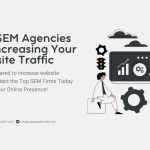Are you struggling to generate leads for your B2B business? If so, then building a high-converting email list should be at the top of your marketing strategy. A carefully curated B2B email list can unlock a wealth of opportunities and help you connect with potential customers who are truly interested in what you have to offer.
But how do you create an email list that not only attracts leads but also converts them into paying customers? In this blog post, we will explore seven powerful strategies that will help you build a robust B2B email list that generates quality leads for your business. From defining your target audience to leveraging social media and personalization techniques, we’ve got you covered! So let’s dive in and take your lead generation efforts to new heights. Get ready to optimize those emails and watch the conversions roll in!
Understanding the Importance of a B2B Email List
One of the key elements in successful B2B marketing is having a solid email list. But why is it so important? Well, think about it this way – your email list is like a direct line of communication with potential customers who have already expressed interest in what you offer.
By having an email list, you can reach out to these prospects on a regular basis and provide them with valuable content, updates, and special offers. This helps build trust and credibility while keeping your brand top-of-mind.
Another reason why a B2B email list is crucial is that it allows you to nurture leads over time. Not everyone who visits your website or engages with your content will be ready to make a purchase right away. With an email list, you can stay connected with these leads and guide them through the buyer’s journey until they are ready to convert.
Moreover, having an engaged email list gives you the opportunity to gather valuable data about your audience. By tracking open rates, click-through rates, and other metrics, you can gain insights into their preferences and behavior patterns. This information can then be used to refine your marketing strategies and tailor future campaigns for better results.
In addition to all these benefits, building a high-quality B2B email list also puts you in control of your marketing efforts. Unlike social media platforms or search engine algorithms that may change their rules overnight, an email list belongs solely to you. You have complete ownership over how you communicate with your subscribers and when.
So don’t underestimate the power of a well-crafted B2B email list! It’s not just about collecting contact details; it’s about establishing meaningful connections with potential customers who are genuinely interested in what you have to offer.
Defining Your Target Audience
One of the key strategies for creating a high-converting B2B email list is to clearly define your target audience. Understanding who your ideal customers are allows you to tailor your messaging and offers specifically to them, increasing the chances of generating leads.
Start by conducting thorough market research to identify the characteristics and preferences of your target audience. Look at factors such as industry, company size, job title, pain points, and goals. This information will help you create buyer personas that represent different segments within your target audience.
Once you have defined your target audience, use this knowledge to craft compelling email content that addresses their specific needs and challenges. Personalization is crucial in B2B marketing, so make sure each email resonates with its intended recipient.
Segmentation is another effective tactic for engaging with different subsets of your target audience. By dividing your email list into smaller groups based on criteria like industry or job function, you can deliver more relevant content and increase engagement rates.
Regularly review and update your buyer personas as market trends evolve. Stay informed about industry news and changes in customer behavior so that you can adapt accordingly.
By defining your target audience with precision and continually refining it over time, you can build a highly targeted B2B email list that consistently generates valuable leads for your business.
Creating Opt-In Forms to Capture Leads
One of the most effective strategies for building a high-converting B2B email list is by creating opt-in forms that capture leads. These forms serve as a gateway for potential customers to provide their contact information in exchange for valuable content or offers.
When designing your opt-in form, it’s important to keep it simple and user-friendly. Avoid overwhelming visitors with too many fields to fill out. Instead, focus on collecting essential information such as name and email address.
To increase conversions, consider offering an incentive such as a free eBook, webinar registration, or exclusive industry insights in exchange for signing up. This will entice prospects and make them more likely to provide their details.
Placement of your opt-in form is crucial. Consider placing it prominently on your website homepage or landing pages where visitors are most likely to see it. You can also experiment with pop-up forms that appear after a certain amount of time or when users exhibit exit intent.
Optimize the design of your form by using compelling copywriting techniques. Craft persuasive headlines and call-to-action buttons that clearly communicate the value proposition of subscribing to your email list.
Don’t forget about mobile responsiveness! With more people accessing websites from their smartphones and tablets, ensure that your opt-in form functions seamlessly across all devices.
By implementing these tactics into the creation of your opt-in forms, you’ll be well on your way to capturing quality leads and growing your B2B email list organically.
Utilizing Social Media for List Building
Social media has become a powerful tool for B2B marketers to build their email lists and generate leads. With billions of users across various platforms, social media provides an extensive pool of potential prospects. Here are some strategies to effectively utilize social media for list building.
Leverage your social media profiles by optimizing them with relevant keywords and clear calls-to-action (CTAs). This will help attract the right audience and encourage them to join your email list.
Create engaging content that resonates with your target audience on social media. Share valuable industry insights, case studies, or educational resources that can entice users to opt-in to your email list.
Additionally, consider running targeted ads on platforms like Facebook and LinkedIn. These ads allow you to reach a specific group of professionals who fit your ideal customer profile. By directing these ad viewers towards a landing page with an opt-in form, you can capture their information and add them to your email list.
Moreover, hosting webinars or live Q&A sessions on social media platforms can be excellent opportunities for lead generation. Require participants to provide their contact details in exchange for access or exclusive offers related to the event.
Furthermore, collaborating with influencers or industry experts in your niche can help expand the reach of your content and increase sign-ups from their followers. Guest posting on relevant blogs or participating in online communities where your target audience is active can also drive more traffic back to your website’s opt-in forms.
Regularly monitor analytics on each platform’s performance metrics such as engagement rates and conversion rates from social media channels. Use this data-driven insight to refine your strategies continually and optimize conversions from these sources.
By leveraging the power of social media effectively, you’ll not only grow your B2B email list but also strengthen relationships with potential customers – ultimately leading to increased sales opportunities!
Leveraging LinkedIn for Lead Generation
LinkedIn, the world’s largest professional networking platform, is a goldmine for B2B lead generation. With over 700 million users worldwide, it offers immense opportunities to connect with potential clients and grow your email list.
To effectively leverage LinkedIn for lead generation, start by optimizing your profile. Ensure that you have a professional headshot, a compelling headline, and a well-written summary that highlights your expertise and value proposition.
Next, join relevant industry groups on LinkedIn where your target audience is likely active. Engage in discussions, share valuable content, and establish yourself as an authority in your field. This will help you build credibility and attract prospects who are interested in what you have to offer.
Another powerful way to generate leads on LinkedIn is by utilizing advanced search filters. Narrow down your search based on specific criteria such as location, industry, job title, or company size to find ideal prospects for your email list.
Once you’ve identified potential leads on LinkedIn, don’t just send them generic connection requests. Personalize each invitation message and mention how you can add value to their professional network or solve a particular pain point they might have.
Additionally, Take advantage of LinkedIn’s publishing platform by sharing informative articles and thought leadership pieces related to your industry. This helps position yourself as an expert while also providing valuable content that can attract potential leads.
Lastly, Consider running targeted advertising campaigns on LinkedIn using sponsored content or InMail messages tailored specifically towards generating leads. These ads allow you to reach out directly to decision-makers within organizations that fit your target market.
Implementing Personalization and Segmentation in Emails
One of the most effective strategies for creating a high-converting B2B email list is by implementing personalization and segmentation in your emails. Gone are the days of sending generic, one-size-fits-all messages to your subscribers. Today, customers expect personalized content that speaks directly to their needs and interests.
Segmentation allows you to divide your email list into smaller groups based on various criteria such as industry, job title, or location. By segmenting your list, you can tailor your messages specifically to each group’s preferences and pain points. This not only increases the relevance of your emails but also improves engagement and conversion rates.
Personalization takes segmentation a step further by customizing emails for individual recipients. Addressing subscribers by name, referencing past interactions or purchases they’ve made with your brand shows that you value their relationship with you.
Additionally, using dynamic content within emails allows you to showcase different products or services based on each recipient’s specific interests. This level of personalization helps build trust and credibility while increasing the chances of conversions.
To implement these strategies effectively, it’s essential to collect relevant data from your subscribers during sign-up or through surveys designed specifically for this purpose. The more information you have about them, the better equipped you’ll be at delivering highly targeted content that resonates with their needs.
Measuring and Analyzing Results for Continuous Improvement
Measuring and analyzing the results of your B2B email list is crucial for continuous improvement. It allows you to gain insights into what is working and what needs adjustment in your email marketing strategy. By tracking key metrics, you can identify patterns, trends, and areas of opportunity.
One important metric to monitor is the open rate – the percentage of recipients who open your emails. A low open rate may indicate that your subject lines are not compelling enough or that your emails are ending up in spam folders. Experimenting with different subject lines and optimizing email deliverability should be a priority.
Click-through rates (CTRs) measure how many recipients clicked on links within your emails. Low CTRs could mean that your content or call-to-action isn’t resonating with readers. Testing different CTAs, improving content relevancy, and making sure links are easily accessible can help increase engagement.
Another valuable metric to consider is conversion rate – the percentage of subscribers who take a desired action after opening an email. This action could be making a purchase, downloading a resource, signing up for a webinar, etc. Analyzing conversion rates helps identify whether your emails effectively drive desired outcomes or if adjustments need to be made to improve conversions.
Additionally, monitoring unsubscribe rates provides insight into subscriber satisfaction and overall effectiveness of your campaigns. If you notice high unsubscribe rates, it’s essential to evaluate the quality and relevance of your content as well as frequency of sending emails.
To gather this data accurately, utilize email marketing analytics tools that provide detailed reports on these metrics. Regularly reviewing these reports will allow you to make informed decisions about refining your messaging strategies based on real-time data.
Remember that measuring alone isn’t enough; analysis plays an equally vital role in identifying patterns and drawing actionable insights from the data collected. Continuously analyze trends over time rather than relying solely on individual campaign performance snapshots.
Conclusion
In conclusion, creating a high-converting B2B email list requires careful planning, strategic targeting, capturing leads through various channels like opt-in forms or social media platforms like LinkedIn; delivering personalized content tailored specifically towards different segments within one’s overall target market; monitoring performance via key metrics which include open rate percentage(s), click-through rate percentages (%) along with conversion ratios – all so as ensure continuous improvement upon successes achieved thus far!


